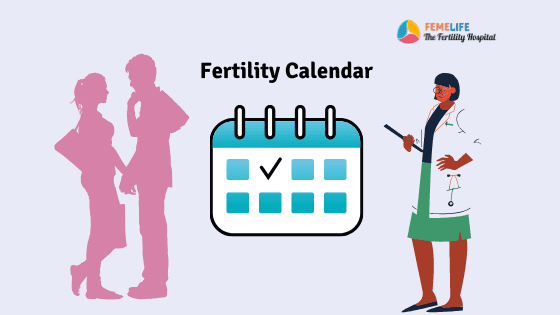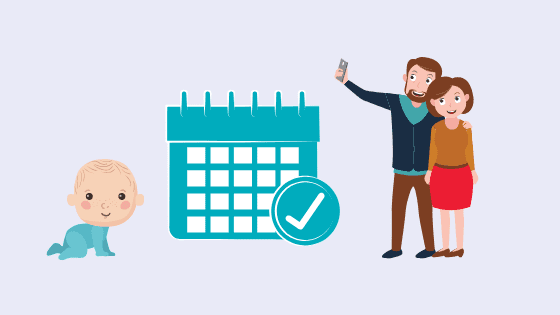
Fertility Calendar
The characteristic of women entering to family life has changed greatly over the past few decades. Young women in more developed countries increasingly delay pregnancy. Some of them choose to complete the childbirth in a predictive manner. Moreover, couples often visit the specialist for information on fertility planning. In addition, you may want to create a fertility calendar according to the need. As a result, your fertility calendar includes conception and contraception.
This includes a health check and vaccinations before pregnancy. With busier lifestyle commitments you may be having less frequent sexual intercourse. So, timed intercourse can help you to assist with conception. Women planning pregnancy expect to conceive quickly. As a result, some enter into depression if they fail do so in next 3 to 6 months.
Fertility Awareness
The fertile window is the time in a woman’s cycle when you can conceive. Consequently, unprotected intercourse can lead to pregnancy. This period typically lasts 6 days around the day of ovulation. Besides, it does vary between women. So, correct timing of intercourse is important. You are more likely to conceive if you plan intercourse prior to ovulation. Moreover, it is important to be aware of your ovulatory cycle.
Subsequently, you have high chances to conceive over next 12 months. Many mobile phone apps may help you to map your ovulation and set a fertility calendar. These technologies help to achieve successful conception or avoiding pregnancy in young women. Additionally, these apps usually ask users to input various biological features and set the fertility calendar for women.
Menstrual Calculator
Each month a woman’s body goes through a number of changes. These changes are mostly hormone dependent as they prepare the woman for a possible pregnancy. This series of events in your body in together are called the menstrual cycle. Usually, women have a menstrual cycle length of 28 days. Your menstrual calendar can predict the next ovulation date and menstrual period. It was developed based on the cyclical changes in the menstrual period and fertility. In this women record their menstrual cycles for family planning. Various medical conditions like PCOS and endometriosis can also be predicted from these charting.
Fertility calendar
Fertility calendar is most widely used to record personal health information. Before the widespread use of mobile phones and computers menstrual calculator was used by woman. Recently different gadgets with self-tracking tools and technologies have replaced the calculator. You can gather various kinds of self-information from this software which make them more popular. Ovulation day can be more accurately determined by ultrasound scanning. It can be combined occasionally with testing luteinizing hormone or oestrogen level in blood.

How do you calculate your fertile days?
Various fertility indicators and measures together make a fertility calendar. Some of the biological features are
- Basal body temperature,
- Cervical fluid consistency,
- Cervical position changes,
- Urine LH tests,
- Electronic fertility monitors, and
- Menstrual cycle calendars.
Fertility Window and Indicators
These fertility indicators help you to track menstrual cycles. You can identify the “fertile window,” to achieve or avoid pregnancy. Fertile window is an approximately 6-day-long interval. During this period intercourse can lead to conception. Each individual has a distinct pattern of ovulatory and menstrual cyclic pattern and set of symptoms.
Measurement of urinary luteinizing hormone (LH) gives an accurate way to determine ovulation. But it is of great importance to select the appropriate assay. The hormone LH peaks prior to ovulation and is excreted quickly in urine. Checking the presence of LH and its products in urine is an excellent way of detecting ovulation.
Implantation or fertile window calculator
Ovulation occurs approximately 14 days prior to menstruation. The days preceding ovulation are important for female fertility and intercourse during these days can result in pregnancy. These are the potentially fertile days and they last around 5 to 7 days in a menstrual cycle. Since these days are important for fertilization and implantation this period around ovulation is called the “fertile window.
One of the markers of fertile window include fertility calendar calculations by previous cycle lengths. In addition, basal body temperature, cervical fluid (mucus), self-palpation of the cervix also can support the calculation. Measurement of reproductive hormones in the urine, including LH and oestrogen or progesterone can add to accuracy.
Advanced Ovulatory Calculator
There are various fertility applications using different algorithms. Besides, most of these fertility apps are generated from user data. They may ask to feed such as date of last menstrual period and cycle length. Cycle length assumption of a 28-day cycle mark ovulation on day 14.
Due to the variability of menstrual cycle length the data obtained from fertility apps may not be reliable. Calendar-based fertility apps if added to biomarkers can give accurate results. LH home kit enables women measurement of the LH surge during women’s cycles and can be used to assess prediction accuracy of calendar apps. These tests adds to accuracy of calendar-based methods for women seeking to become pregnant.
How many days after period are you fertile?
Fertility awareness-based methods help to plan or prevent pregnancy. In short, they rely on the accurate identification of the fertile days in a woman’s menstrual cycle. After ovulation a woman’s egg can survive up to 24 h and sperm can survive for up to five days in the female reproductive tract. Accordingly, the fertile window is restricted to six days per cycle and the day of ovulation and the five preceding days.
Can I get pregnant 5 days after my period?
During the average woman’s menstrual cycle there are six days when intercourse can result in pregnancy. This “fertile window” or fertile period comprises the five days before ovulation and the day of ovulation itself. In only about 30% of women is the fertile window is between days 10 and 17. Rest of the women reach their fertile window earlier and or much later. You should know that the timing of their fertile window can be highly unpredictable. Even though your cycles are regular you have a chance of conceiving beyond this window in fertility calendar.
How accurate is the fertility calendar?
If you avoid sex on specific days of the menstrual cycle, you can prevent pregnancy up to some extent. This remains a method of family planning for many couples worldwide. But you should be aware that no calendar method is completely effective. There are few days in the menstrual cycle during which some women are not potentially capable of becoming pregnant. But prediction of these days is highly unreliable.
Can I prevent pregnancy by ovulation calculation?
The calendar-based methods can successfully predict your fertile window up to 50% of cases. However, calculating ovulation is highly unreliable. Women following fertility calendar method for contraception often land in an unplanned pregnancy. Indeed, it would only be possible to predict ovulation accurately by giving users an 8–10-day window. This window can be used to plan sexual intercourse,
The true day of ovulation varies considerably for any given cycle length. Therefore, calendar/app methods can not provide you with an accurate prediction of the day of ovulation. You should consult fertility specialist for advice on timing of sexual intercourse to achieve pregnancy.
Advanced ovulation calculator
Natural cycle fertility calendar is a fertility awareness method to understand reproduction. Mobile applications using the fertility calendar method often misguide couple. These apps combined with a symptom-based algorithm can give better results. In addition, you can analyze cycle-by-cycle menstruation data. In fact, this method determines the fertile window based on basal body temperature (BBT) and optional urinary tests of luteinizing hormone (LH). The prediction of the fertile window for ovulation day takes into account cycle length, luteal/follicular phase length and average temperature. Ovulation is more confirmatory following detection of the BBT rise.
Advanced ovulation calculator
Here are various calculations for a fertility calendar.
The Ogino method
This assumes a fixed length of the luteal phase of 14 days and predicts the ovulation date. You can calculate 15 days after the onset of the previous menstruation for a particular as ovulation date. Therefore, the Ogino method is the most widespread calendar-based method relied on by women.
Half cycle length method
This second method is the method proposed by Lamprecht and Grummer-Strawn. You can easily calculate the ovulation date by dividing the cycle length by two. Thus, this method predicts a woman’s next ovulation date as [cycle length/2] days after the onset of the previous menstruation. Moreover, this is a simple method over other calendar-based methods. In conclusion, it reflects individual differences in the length of the luteal phase in a menstrual cycle.
The Optimized method
This method predicts a woman’s next ovulation date as a function of follicular phase length. As a result, the ovulation day is optimized by days after the onset of the previous menstruation. It includes individual variation in menstrual cycle.
Fertile days after period
Awareness of one’s own fertility is considered important for fertility treatment. Additionally, it helps women to become pregnant in a shorter period of time. Fertility depends on the menstrual cycle length, and in each cycle, there is a “fertile window”. Calculating this window helps you to know the time during which they can conceive. Standard days method in menstrual cycles suggest that the fertile window starts 5 days prior to ovulation and ends on the day of ovulation.
Fertility after ovulation
Your pregnancy rate starts increasing 8 days prior to ovulation. Furthermore, it peaks after 6 days (2 days prior to ovulation). It reaches almost zero at 2-3 days after ovulation. Hence, it is important for a woman to be able to predict the next ovulation date. It is important in the course of her menstrual cycles. Various ovulation predictor kits are available for this purpose.
Prediction of ovulation in present day
The present calendar methods of predicting the ovulation date need more refining. Calendar methods require only the timing of menstruation. On the whole, one of the calendar methods is the best option for you during the early stages. It may be less effective for those who want to avoid a pregnancy.
A fertility calendar is a low-cost, low-burden method for achieving pregnancy. In addition, cycle charting reduces the time to pregnancy. Small reductions in time to pregnancy may not be clinically meaningful. But, they may help couples to better time pregnancies and reduce anxiety. These advantages make the fertility calendar a good option for couples who want to be proactive in fertility planning.
